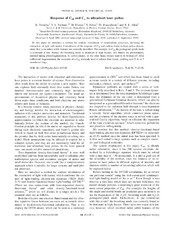| dc.creator | Torralva, B. | |
| dc.creator | Niehaus, TA | |
| dc.creator | Elstner, M. | |
| dc.creator | Suhai, S. | |
| dc.creator | Frauenheim, T. | |
| dc.creator | Allen, Roland E. | |
| dc.date.accessioned | 2012-09-19T20:00:40Z | |
| dc.date.available | 2012-09-19T20:00:40Z | |
| dc.date.issued | 2001 | |
| dc.identifier.citation | B. Torralva, TA Niehaus, M. Elstner, S. Suhai, T. Frauenheim and Roland E. Allen. Phys.Rev.B 64 153105 2001."Copyright (2001) by the American Physical Society." | en |
| dc.identifier.uri | http://dx.doi.org/10.1103/PhysRevB.64.153105 | |
| dc.identifier.uri | https://hdl.handle.net/1969.1/146789 | |
| dc.description | Journals published by the American Physical Society can be found at http://journals.aps.org/ | en |
| dc.description.abstract | In this paper we introduce a method for realistic simulations of nonadiabatic processes, including the interaction of light with matter. Calculations of the response Of C(60) and carbon chains to laser pulses demonstrate that even rather subtle features are correctly described. For example, in C(60) the pentagonal-pinch models dominant at low fluence, the breathing mode is dominant at high fluence, and dimers are preferentially emitted during photofragmentation. In carbon chains, on the other hand, trimers tend to be broken off. After collisional fragmentation, the remnants of a C(60) molecule tend to reform their bonds, yielding new 5, 6, or 7 membered rings. | en |
| dc.language.iso | en | |
| dc.publisher | American Physical Society | |
| dc.rights | This work is archived in the Texas A&M Digital Repository with the express permission of the rights holder (commonly but not always the publisher). A copy of the permission document is on file with the Texas A&M University Libraries. | en |
| dc.subject | DENSITY-FUNCTIONAL THEORY | en |
| dc.subject | CARBON | en |
| dc.subject | FRAGMENTATION | en |
| dc.subject | SIMULATIONS | en |
| dc.subject | FULLERENE | en |
| dc.subject | DYNAMICS | en |
| dc.subject | SYSTEMS | en |
| dc.subject | Physics | en |
| dc.title | Response of C(60) and C(n) to ultrashort laser pulses | en |
| dc.type | Article | en |
| local.department | Physics and Astronomy | en |


